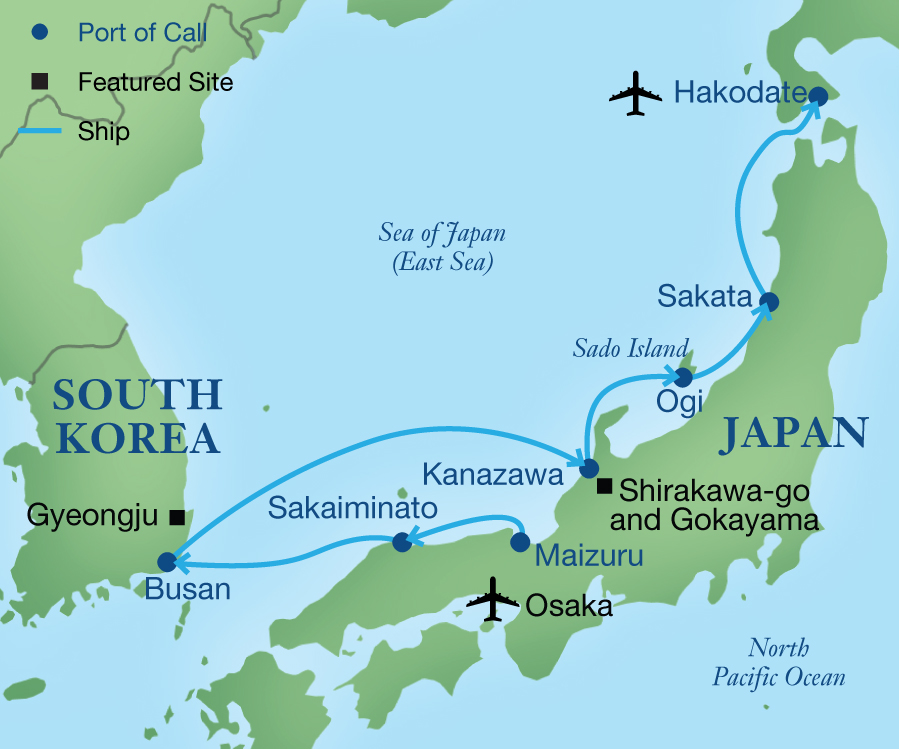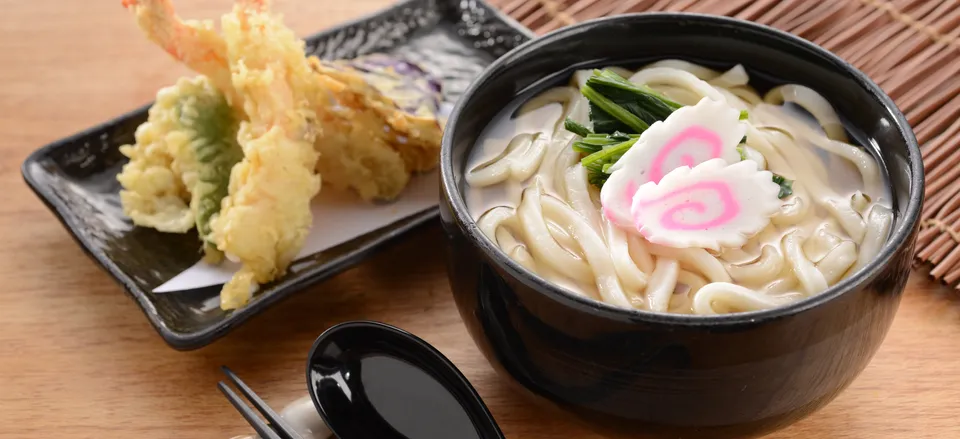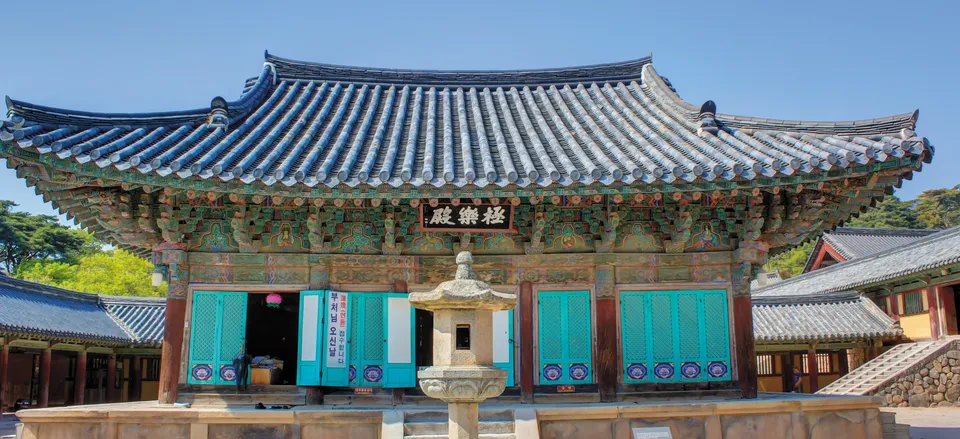A NEW cruise offering from Smithsonian Journeys and PONANT
Trace the northwest coast of Honshu, exploring lesser-known towns and villages that harbor the hallmarks of Japan’s rich culture: from traditional crafts and Japanese gardens to historic castles and shrines.
Cultural and Natural Treasures of Japan by Sea
Aboard the 264-guest Le Soléal
8 days from $7,970
A NEW cruise offering from Smithsonian Journeys and PONANT
Trace the northwest coast of Honshu, exploring lesser-known towns and villages that harbor the hallmarks of Japan’s rich culture: from traditional crafts and Japanese gardens to historic castles and shrines.
Overview

Tokyo & Kyoto Pre-Cruise Extension - 5 days, 4 nights
Japan is a country pulled in two radically different directions, deeply honoring its past while rushing headlong into the future. Hyper-modernity exists side by side with the quiet serenity of ancient shrines and gardens. Nowhere is this contrast more apparent than in the experience provided by this 5-day program in Tokyo and Kyoto, as you move between the steel and glass of modern skyscrapers and the wood and bamboo structure of Zen temples. From the gleaming storefronts of Tokyo's Ginza district to the serene gardens of Kyoto, you will have the opportunity to see how Japan has managed to blend tradition and modernity.
Day 1 – Tokyo
Arrive at Tokyo International Airport, where you will be met and transferred to the Hotel New Otani in the center of the city, your home for the next two nights. A local representative will be present at a hospitality desk in the afternoon to welcome you and answer any questions you may have. Relax and enjoy the many amenities of this stunning complex before joining your fellow travelers for a welcome cocktail reception this evening. Dinner is independent.
Day 2 – Tokyo
After breakfast at the hotel, join a full day excursion that samples some of best that Tokyo has to offer. Explore the Tokyo National Museum, one of the largest art museums in the world, with a rich and extensive collection of Asian art and cultural artefacts. Lunch at a local restaurant is followed by a visit to Sensoji Temple, first built in 645 to house a tiny statue of the goddess of mercy, where the temple precincts bustle with people praying, shopping and sightseeing. Stroll the Asakusa and Nakamise shopping arcade, one of the oldest shopping districts in Tokyo. Later in the afternoon, visit the Meiji Jingu Shrine, which is dedicated to the great-grandparents of the present emperor and whose vast grounds of more than 100,000 trees serves as both a sacred Shinto space and as an oasis of tranquility within the fast-paced city. Dinner is independent.
Day 3 – Tokyo | Kyoto
Breakfast at the hotel is followed by a morning excursion to Tokyo's Ginza district. Named for the silver mint located here in the 17th and 18th centuries, Ginza is now the city's largest upmarket shopping district. After a short guided walking tour of the area's landmarks, explore the myriad department stores, boutiques, and art galleries, and enjoy an independent lunch in one of Ginza's many restaurants. Leaving Ginza, transfer to the train station to catch the bullet train to Kyoto, where you check in to the Kyoto Brighton Hotel for two nights. Independent dinner.
Day 4 -- Kyoto
Explore Kyoto on a full day tour, starting with a visit to the Kinkakuji Temple complex to see the Golden Pavilion, so named because of the gold leaf covering its two upper stories. Built by shogun Ashikaga Yoshimitsu as a villa, it was converted to a Zen temple following his death in 1408. Also visit the nearby Ryoanji Temple, home to Japan’s most famous rock garden. Following lunch at a local restaurant, travel to the Arashiyama district on the western edge of Kyoto, once popular with nobles who enjoyed its natural setting. Walk through the famous bamboo groves and visit Tenryuji Temple, built in the 13th century and one of Kyoto’s greatest Zen temples. The balance of the day is at leisure to explore Kyoto on your own. Dinner is independent.
Day 5 -- Kyoto | Maizuru | Embark
Travel this morning to Nijo Castle, built in 1603 as the Kyoto residence of Tokugawa Ieyasu, the first shogun of the Edo Period (1603-1867). After exploring this UNESCO World Heritage Site, visit a traditional machiya residence and participate in a tea ceremony, learning the history of this iconic Japanese custom and experiencing the spirit of Japanese hospitality. Following lunch at a local restaurant, relax during the two hour drive to Maizuru to embark Le Soléal.
Your hotels:
The 4-5-star Hotel New Otani Tokyo is located close to Tokyo Imperial Palace, and features on site shopping, 3 coffee shops/cafes, and 20 onsite restaurants. All 563 rooms have deep soaking tubs, bathrobes, hair dryers, HDTVs and refrigerators. The hotel has its own Japanese garden, tea house, outdoor swimming pool, spa salon, barbershop and hair salon.
Located close to Kyoto Imperial Palace and Nijō Castle, Kyoto Brighton Hotel provides shopping on site, a hair salon, and dry cleaning/laundry services. Four onsite restaurants feature Japanese cuisine and more. All 182 rooms have Memory foam beds, rainfall showers and deep soaking tubs, 32-inch HDTVs with satellite channels, and free Wi-Fi.
Your program includes:
- 2 nights at the Hotel New Otani in Tokyo (or similar)
- 2 nights at the Kyoto Brighton Hotel (or similar)
- Transfer and luggage handling from the airport to the hotel on the scheduled program arrival day
- Transfer and luggage handling from the hotel to the ship on embarkation day
- Welcome Reception on Day 1
- Breakfast on Days 2, 3, 4, and 5
- Lunch on Days 2, 4, and 5
- Tea Ceremony on Day 5
- Sightseeing and programming as noted in the itinerary
- Local English-speaking guide
- Gratuities for the drivers and local guides
Your program does not include:
- Transfer from the airport to the hotel on any day other than the scheduled program arrival day
- Personal expenses and other services and meals not mentioned as included in the program
Please note:
- It is imperative that your flight arrival details are communicated at least 30 days prior to the beginning of your cruise in order to secure your transfer from the airport to the hotel.
- Early check-in and/or late check-out are available depending on availability and at a supplement. Please, contact reservations or your travel agent for further details.
- The official currency is the yen and credit cards are widely accepted in hotels, shops, and restaurants.
- This pre-cruise program is offered as a package. There will be no refunds for unused accommodations, meals, or excursions.
- Program is offered on a space available basis.
- Program is subject to change without notice.
To see itinerary, please click on an option below.
Itinerary
Day 1 – Maizuru, Japan (via Osaka)
Arrive into Osaka and transfer to Maizuru, a port city north of Kyoto on the Sea of Japan. Settle into your cabin late in the afternoon, and sail west this evening. (D)
Day 2 – Matsue and Yasugi
Go ashore in Sakaiminato and explore the region on one of three excursions. Visit the exquisite Adachi Museum of Art, set amid Japanese gardens considered some of the most beautiful in the country and home to a world-class collection of Japanese modern art. Witness the evolution of artistic styles from the Meiji Period through the 20th century, and admire works by prominent artists such as Yokoyama Taikan. Continue to Daikonshima Island, in the middle of Lake Nakaumi, for a visit to Yushien Garden, known for its abundance of blooming peonies in the spring.
Or choose to travel to Matsue Castle, built in 1611 and one of the few original castles that remain in Japan. See a collection of samurai swords and armor and take in sweeping views from the donjon. Then delve into the art of Japanese paper-making, or washi. Visit a museum dedicated to a master craftsman and try your hand at this ancient art, now recognized as UNESCO intangible cultural heritage.
Alternatively, surround yourself with brilliant blossoms at the Tottori Hanakairo Flower Park, where fields of seasonal flowers encircle a domed greenhouse full of tropical flora. Then visit Kotobuki-jo, or “Sweets Castle,” a replica of a historic castle, that offers beautiful views—and traditional Japanese candies. On your return to the ship, see the bronze statues of manga characters that line Mizuki Shigeru Road. This afternoon, set sail for the Korean Peninsula. (B,L,D)
Day 3 – Busan or Gyeongju, South Korea
Arrive in the port city of Busan, a former colony of Japan that is now South Korea’s second-largest city. Take in the view from Gwangan Grand Bridge, Korea’s longest suspension bridge, on your way to Haedong Yonggungsa Temple, a colorful temple originally built in the 14th century that sits picturesquely atop seaside rocks. Return to Busan to visit the Busan Museum of Arts and sculpture garden, or head to the Jagalchi Fish Market for a glimpse into everyday life in Busan. Alternatively, travel to Hongbeopsa Temple, home to the largest Buddha statue in Asia. Or choose a full-day excursion to the historic city of Gyeongju, cradle of the Silla Kingdom (57 B.C. to A.D. 935), and its glorious World Heritage-designated Bulguksa Temple. Continue to the royal burial mounds at Tumuli Park and venture into the 5th-century Cheonmachong, or “Flying Horse” tomb. Our final stop is the Gyeongju National Museum, which houses a treasure trove of Silla artifacts. (B,L,D)
Day 4 – At Sea
Spend a leisurely day at sea as you cross the Sea of Japan back to Honshu. Indulge in a treatment in the spa or read a book in the library. Visit the ship’s upper deck to take in views of the open sea and enjoy meals or afternoon tea with newfound friends. Our Smithsonian Journeys Experts will give talks on the region and lead engaging discussions. (B,L,D)
Day 5 – Kanazawa or Shirakawa-go, Japan
Having been spared from damages during World War II, Kanazawa is a vibrant hub of Japanese history, culture, and craft. Set out on a guided tour, beginning with a walk through the Omicho Market, a vital part of city life where merchants sell street food, flowers, fresh seafood, and much more. Then stroll past wooden facades and traditional teahouses in Higashi Chayagai, an Edo-period geisha district. Visit a gold leaf workshop for an introduction to a traditional art form that has been practiced here since the 7th century. Meet with artisans and observe up close the meticulous process of flattening small amounts of gold into incredibly thin sheets used to cover temples, lacquerware, and more.
Or experience the world renowned Kenrokuen Garden, a national landmark that dates back to the 1600s. At the Gyokusen-an teahouse, on the grounds of Kanazawa Castle, witness an authentic Japanese tea ceremony. Then learn about the culture of the samurai at the stunning Nomura Samurai Residence, built around a serene rock garden. After lunch, take a walk through Higashi Chayagai and visit the Kutani Kosen Kiln, where artists craft intricately decorated ceramics.
You may instead choose a full-day excursion to the World Heritage sites of Shirakawa-go and Gokayama, where residents of remote farming villages developed a unique way of life adapted to their isolated mountain setting. Learn about vibrant local traditions and admire unusual, thatched-roof architecture, known as gassho-zukuri, designed with a steep pitch to resist heavy snowfall. In Gokayama, you’ll have another chance to see how handmade Japanese washi paper is made using local fibers. (B,L,D)
Day 6 – Sado Island
Spend today on Sado Island, once a place of exile for Japanese political prisoners. Choose to visit the Edo-era fishing village of Shukunegi, a warren of narrow lanes and picturesque wooden houses. Visit the Ogi Folk Museum to see a fascinating array of artifacts from traditional fisheries and shipyards as well as everyday island life. Continue to the Hokusetsu Sake Brewery for a tasting of the rice wine that has been produced here for more than 150 years. Or head to the northern part of the island to explore the lovely small bays and cliff-edged shores of Senkaku-wan Bay Ageshima Yuen Park. At the Sado Kinzan Gold Mine, enter underground tunnels for a closer look at Japan’s most productive gold mining operation, which stopped production in 1989. Stop to see the acred Meoto Iwa, or “wedded rocks” on your way back to the ship. As a special treat, you are invited to attend an exclusive presentation of taiko drumming by the world-famous drumming group, Kodo, while on Sado Island. (B,L,D)
Day 7 – Sakata and Yamagata
Awaken in Sakata, on the coast of the mountainous Yamagata region, and enjoy the excursion of your choice. Browse a spectacular collection of traditional Japanese arts at the Homma Museum of Art, where lacquerware, ceramics, and even dolls are housed in the beautiful home of a powerful Edo-period family. Admire images of post-war Japan at the Ken Domon Museum of Photography, then visit the Sankyo Rice Storehouse to learn how Japan’s culinary staple has been cultivated and stored using fascinating methods. Or venture to the slopes of sacred Mount Haguro to see its 600-year-old, five-story pagoda, a masterful feat of engineering built without any nails. Ascend to the thatched shrine of Sanjin Gosaiden, a revered pilgrimage site dedicated to the three mountains that surround it. Alternatively, immerse yourself in nature on an excursion to Mount Chokai and Tamasudare Falls, which drop some 200 feet; or observe the mesmerizing movements of hundreds of ethereal jellyfish at the Kamo Aquarium before a visit to the Sankyo Rice Storehouse. (B,L,D)
Day 8 – Hakodate, Hokkaido / Return Home
After breakfast, disembark in the town of Hakodate on Japan’s northernmost main island of Hokkaido. Extend your stay to explore Hokkaido further, or transfer to the airport for your flight home. (B)
Included meals are denoted as follows: Breakfast (B), Lunch (L), Reception (R), Dinner (D)

/https://tf-cmsv2-journeys-media.s3.amazonaws.com/filer_public/99/3f/993f7b34-eda6-48ec-9dd5-b7b918c8cf6c/jpn_matsuecastle_ss_1100296799.jpg)
/https://tf-cmsv2-journeys-media.s3.amazonaws.com/filer_public/6b/f7/6bf7eaba-f5e7-4b02-a7d7-45db9e0df068/jpn_matsue_adachigarden_ss_1015373431.jpg)
/https://tf-cmsv2-journeys-media.s3.amazonaws.com/filer/81/d0/81d0c0cc-d2c0-4050-8cee-adbf2d6fe4c1/jpn_kanazawa_kenrokuengarden_ss_1140276437_copy.jpg)
/https://tf-cmsv2-journeys-media.s3.amazonaws.com/filer_public/33/80/33802369-b387-4b27-81d6-dbc018bf3805/jpn_kanazawa_higashi_chaya_district_ss_1025075212.jpg)
/https://tf-cmsv2-journeys-media.s3.amazonaws.com/filer_public/cd/24/cd24e8a2-b8b5-4f6e-a333-a7e17e0fa01a/jpn_papermaking_ist_1129108337.jpg)
/https://tf-cmsv2-journeys-media.s3.amazonaws.com/filer_public/7b/d2/7bd26a94-d9a1-445f-a945-49db0bb0edfb/jpn_teaceremony_ist_544590230.jpg)
/https://tf-cmsv2-journeys-media.s3.amazonaws.com/filer_public/74/5a/745a64af-1f7a-4a9d-8b8c-3e95b1e218bf/jpn_goldleafworkshop_ist_1129177741.jpg)

/https://tf-cmsv2-journeys-media.s3.amazonaws.com/filer_public/6d/e3/6de36720-ece0-47d3-9c02-ee3c03cedbb3/jpn_taikodrumming_ist_182360343.jpg)
/https://tf-cmsv2-journeys-media.s3.amazonaws.com/filer_public/d0/79/d0797e23-457c-45bf-9b67-dcf4d6221f31/jpn_shirakawavillage_gettyrfdisc_aa016762.jpg)
/https://tf-cmsv2-journeys-media.s3.amazonaws.com/filer_public/62/97/6297196b-898c-4aac-8d8f-215bbae7ab1e/jpn_shirakawago_whsite_ss16260922.jpg)
/https://tf-cmsv2-journeys-media.s3.amazonaws.com/filer_public/6a/5a/6a5a9d9a-4acb-4c84-97fb-4b833b036b28/jpn_mthaguro_5storiedpagoda_ss_623040989.jpg)
/https://tf-cmsv2-journeys-media.s3.amazonaws.com/filer_public/ec/27/ec27ab87-1150-4637-b9d4-67fafa651752/jpn_womanfishingvillage_pon_0o5a7706_r_so110423_toshiko_kurano_julienfabro.jpeg)
/https://tf-cmsv2-journeys-media.s3.amazonaws.com/filer_public/cb/87/cb876422-b6c3-45dc-98c2-56a7a66da94d/skr_gyeongju_temple_ss_1114897469.jpg)

/https://tf-cmsv2-journeys-media.s3.amazonaws.com/filer_public/00/41/00415ad1-1b9e-4dec-86d1-44c3f0ada3a5/skr_gyeongju_bulguksatemple_warriorguardians_ss_1017561628.jpg)
/https://tf-cmsv2-journeys-media.s3.amazonaws.com/filer_public/fb/3f/fb3f6315-e848-4635-a82c-6794de9f484b/skr_busan_haedongyonggungsatemple_ss_302829581.jpg)
/https://tf-cmsv2-journeys-media.s3.amazonaws.com/filer_public/f8/d6/f8d66950-625a-40b8-836b-a2749b9d6b73/skr_busan_hongbeopsa_temple_ss_1437264275.jpg)
/https://tf-cmsv2-journeys-media.s3.amazonaws.com/filer_public/91/06/91065c0d-97d5-45c2-9e0b-e67c06b2ab18/skr_busan_jagalckifishmarket_ss_2289026541.jpg)
/https://tf-cmsv2-journeys-media.s3.amazonaws.com/filer/cc/94/cc9461b0-e696-4b73-8ead-90dfe60a2848/family_jpn_dinner_ist_000020604142_full.jpg)
:focal(1831x1255:1832x1256)/https://tf-cmsv2-journeys-media.s3.amazonaws.com/filer/92/7d/927d3e61-c78e-4ea2-8136-be7ae18c75a6/jpn_kyoto_monk_chijon-jibuddhistshrine_ist_638800102.jpg)
/https://tf-cmsv2-journeys-media.s3.amazonaws.com/filer/5d/66/5d66c19f-1dc4-48c0-8f32-16a80d625f9b/jpn_miyajima_itsukushimatoriigate_dt_xl_26226802_forweb.jpg)